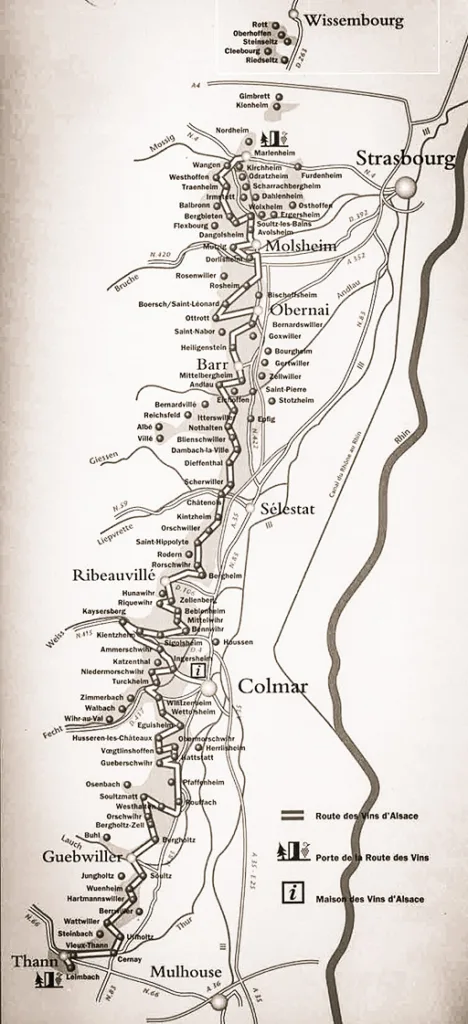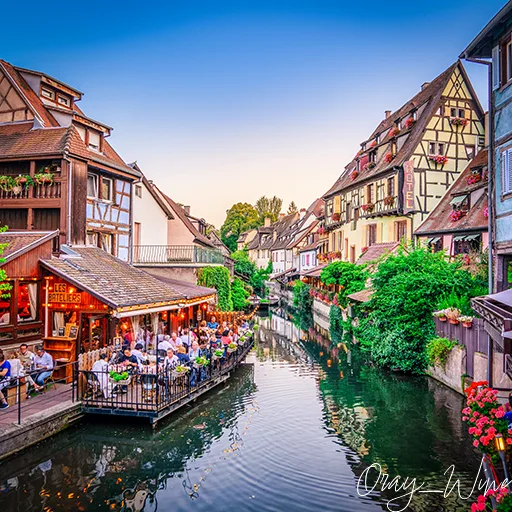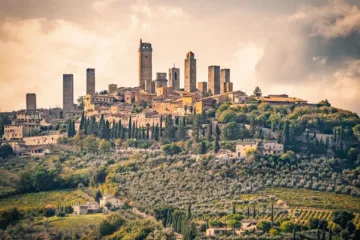The Alsace region is located in eastern France on the border with Germany. There are 51 Grands Crus. The Grands Crus of Alsace represent the top of the quality pyramid of Alsace wines. These wines come exclusively from the best terroirs (click here to find out more about the notion of ‘Terroir’). These 51 Grands Crus are spread over 47 municipalities which are spread over a strip of land of 170 km between the Massif des Vosges and the Rhine River.

The climate of the Alsatian region
Alsace enjoys a continental climate. The summers are hot and the winters cold. This continental climate is marked by significant seasonal thermal amplitudes as well as a strong diurnal thermal amplitude. Cool nights favor the retention of natural acidity in the grapes. This preserves the liveliness and freshness of the wines on the palate.
It should be noted that the Alsatian region is protected from climatic hazards coming from the Atlantic Ocean thanks to the Massif des Vosges. Due to the protective effect of the Massif des Vosges, the region receives one of the lowest rainfall rates in France (only 394mm to 495mm per year).

Topology of the Alsatian region

Alsace is located in the Rhine ditch (or ‘Graben’ of the Rhine). A ‘Graben’ is a pit between two faults made up of compartmentalized plates, a bit like stairs. This pit is the result of the gradual subsidence of the plains between the two parallel faults.
The different types of soil in Alsace
Alsace is known for the great diversity of its soils. In all, 13 different types of soil have been identified in Alsace. This includes volcanic, granitic, gneiss, shale, sandstone, limestone, marl, sand, loess, silt.

The Alsace wine route: a unique experience
The Alsace Wine Route, which was inaugurated in 1953, is in fact the oldest wine route in France. She celebrates her 70th birthday in 2023. She is known all over the world. It crosses a number of typical Alsatian villages. This is a real postcard decor. Between half-timbered houses and castles. At the gates of the European capital, the vineyards around Strasbourg extend from Marlenheim to Molsheim through an astonishing medieval heritage and green landscapes mixing vineyards and orchards.
The most famous and typical towns are probably Colmar, Bergheim, Ribeauvillé and Riquewihr.

The 51 Grands Crus of Alsace
To access the Alsace Grand Cru appellation, wines must come from grapes produced in one of the vineyards designated as ‘Grand Cru’. The quality of these is generally quite exceptional.
Only 51 vineyards represent 4% of the total production in Alsace. All Grands Crus d’Alsace wines are white wines. The main grape varieties used are Riesling, Pinot Gris, Muscat and Gewurztraminer. The Sylvaner grape variety is only authorized in one Grand Cru: Zotzenberg.
Most of the 51 Grands Crus are monovarietal white wines. However, there are two exceptions: the Alsace Grand Cru ‘Altenberg de Bergheim’ and the Alsace Grand Cru ‘Kaefferkopf’. Because of these two exceptions, it is not mandatory for Grands Crus d’Alsace wines to mention the grape variety used on the wine label.
List of the 51 Grands Crus appellations of Alsace (white wines)
- Altenberg (Bergbieten)
- Altenberg (Bergheim)
- Altenberg (Wolxheim)
- Brand (Turckheim)
- Bruderthal (Molsheim)
- Eichberg (Eguisheim)
- Engelberg (Dahlenheim )
- Florimont (Ingersheim-Katzenthal)
- Frankstein (Dambach la ville)
- Froehn (Zellenberg)
- Furstentum (Kientzheim-Sigolsheim)
- Geisberg (Ribeauvillé)
- Gloeckelberg (Rodern-St Hippolyte)
- Goldert (Gueberschwihr)
- Hatschbourg (Hattstatt-Voegtlinshoffen)
- Hengts (Wintzenheim )
- Kanzlerberg (Bergheim)
- Kastelberg (Andlau)
- Kessler (Guebwiller)
- Kirchberg (Barr)
- Kirchberg (Ribeauvillé)
- Kitterlé (Guebviller)
- Mambourg (Sigolsheim)
- Mandelberg (Mittelwihr et Beblenheim)
- Marckrain (Bennewihr-Sigolsheim)
- Moenchberg (Andlau-Eichhoffen)
- Muenchberg (Nothalten)
- Ollwiller (Wuenheim)
- Osterberg (Ribeauvillé)
- Pfersigberg (Eguisheim et Wettolsheim)
- Pfingstberg (Orschwihr)
- Praelatenberg (Kintzheim)
- Rangen (Thann-Vieux Thann)
- Rosacker (Hunawihr)
- Saering (Guebwiller)
- Schlossberg (Kientzheim)
- Shoenenbourg (Riquewihr-Zellenberg)
- Sommerberg (Niedermorschwihr et Katzenthal)
- Sonnenglanz (Beblenheim)
- Spiegel (Bergholtz & Guebwiller)
- Sporen (Riquewihr)
- Steinert (Pfaffenheim et Westhalten)
- Steingrubler (Wettolsheim)
- Steinklotz (Marlenheim)
- Vorbourg (Rouffach et Westhalten)
- Wiebelsberg (Andlau)
- Wineck-Schlossberg (Katzenthal-Ammerschwhr)
- Winzenberg (Blienschwiller)
- Zinnkoepflé (Soultzmatt-Westhalten)
- Zotzenberg (Mittelbergheim)

Follow me on my Social Media
Wine is a gourmet treasure, do not abuse alcohol!
None of this content has been sponsored
I did not receive any gifts or free samples that could be related to this article


